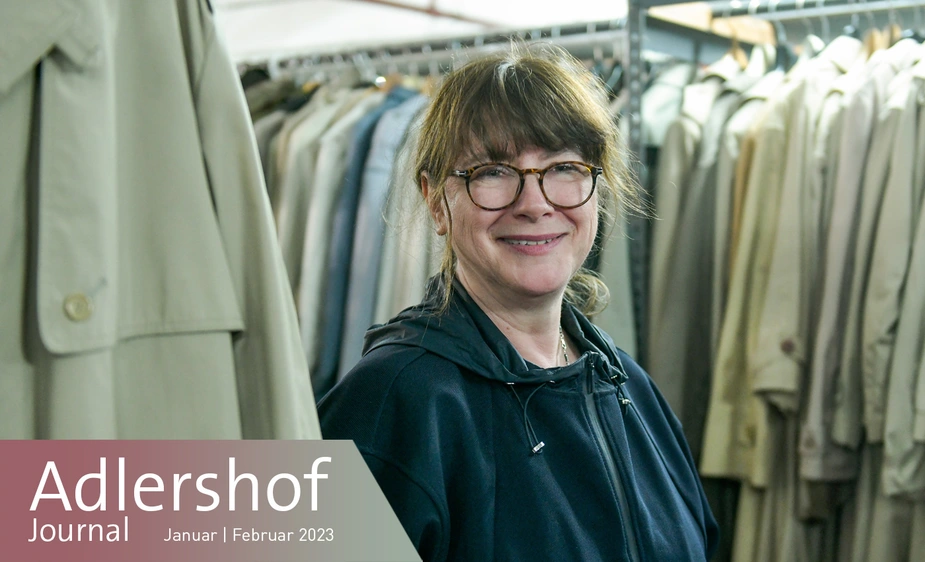“Ours is not a supporting role but a main role”
Anne Becker of Adlershofer Fundus, Adlershof’s prop and costume inventory, about the striking similarities to the hierarchical world of the film “The Ordinaries”
A visit to Adlershofer Fundus can be overwhelming. On an area of 4,000 square metres in a cellar of Ernst-Augustin-Strasse 7, you will find the crowns of kings and knight’s armour, bus stop signs, old books, bags, radios, television sets spanning seven decades, old typewriters, and suitcases. Anne Becker, the director of Adlershof’s prop and costume inventory, helped with setting up productions including A Stasi Comedy by Leander Haußmann, “Fabian: Going to the Dogs”, and “The Palace”. As if it were nothing, she mentions that the massive wooden table we were passing at that moment was used to produce the fourth “John Wick” movie with Keanu Reeves.
What made Becker prick up her ears was when Sophie Peters, a costume designer, chose Adlershofer Fundus for her social satire “The Ordinaries” (In theatres: 30 March 2023). “The Ordinaries” is set directly in the movie world. This world is made up of main and supporting characters while some characters lead a life as “outtakes” on the margins of society because they were cut out of the main film. For Becker, supporting Peters in her work was a great pleasure: “I was very curious to see how Sophie Peters, as an experienced and creative costume designer, would put the topic into practice. The challenge was to use the conventional tools of a costume designer to design a main role that played a ‘supporting role’ in the movie.
The main character of the movie is Paula (Fine Sendel). However, her real role has not been decided yet, which is why she goes to the “main character school” to make it big in life. Paula goes in search of her own personal soundtrack. Until she finds it, she sounds out of tune, and the colour of her skin and her clothes are pale. A trick used by costume designer Sophie Peters “to make visible the hierarchical order of the characters in the film by way of their costumes. There are dress codes for the different groups that are clearly recognisable." In contrast to the supporting characters, the main characters wear costumes in vibrant colours and thus take the spotlight easily. “The pattern design she uses is full of references to the rather conservative 1950s/60s. Behind the perfect images and the rousing song and dance performances, the social oppression of the others is thinly veiled at best,” says Peters. The main character comes first.
Becker beams: “Naturally, this is exciting because the plot deals with something that we experience first-hand at the prop and costume inventory. Depending on whether the costume is for a main or a supporting role, it can be custom-made, changed, or simply thrown over. Less effort is made for supporting roles.” She thinks of the costume of Paula’s mother (Jule Böwe) for example. Becker walks towards a hundred coats. A beige coat with a button placket, without a button placket, long, medium, or short. Which coat made it into the movie, in the end, was decided by Peters. The costume designer opted for a slightly flared coat with a simple cut. The supporting characters blur with their surroundings due to colour and shape.
Sophie Peters discovered Adlershofer Fundus only through “The Ordinaries”, Sophie Linnenbaum’s final film. “I really enjoy working with Adlershofer Fundus, not only because of the large selection of costumes, but also because Anne Becker is very flexible and responds to a project’s individual needs.”
Becker also greatly appreciated working together with Sophie Peters. Unfortunately, says Becker, not all production teams are aware of the value of the Fundus. In budget planning, the prop and costume inventory is treated in a stepmotherly fashion. “I have experienced that a graduation film had a budget of 12,000 euros where 4,000 euros for earmarked for catering but 800 euros for costumes. Unfortunately, this is not uncommon,” says Becker. Warningly, she says: “Ours is not a supporting role but a main role in film production.”
Linnenbaum's unusual narration concept is well received. “The Ordinaries” received the German Cinema New Talent Award for best director and best production at Filmfest München, Munich’s International Film Festival, and the First Steps Award. The film was also shown at the international competition of the International Film Festival in Karlovy Vary. Anne Becker is very pleased to have made such a significant contribution to his. “I care deeply about the young generation, and it is so nice when the Fundus can contribute to the success of the film as one of many important elements.”
Susanne Gietl for Adlershof Journal
